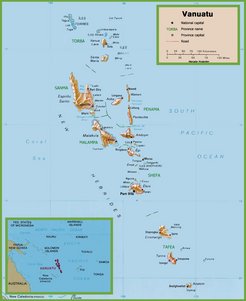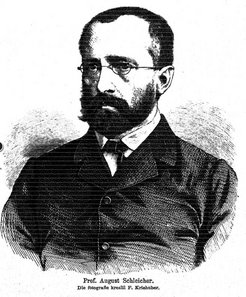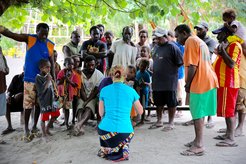On the trail of the Galapagos of language evolution
Estimates put the number of different languages in the world at around 7,000. In contrast to Europe where language boundaries normally coincide with national borders, different languages coexist in many regions of the earth – with the densest concentration in Vanuatu, a southern Pacific island state with only 260,000 inhabitants but around 120 languages. Russell Gray and his team at the Max Planck Institute for the Science of Human History are documenting the diversity of the languages and exploring the question of how this situation came about.
Text: Jeannette Goddar
There are scenes which leave a lasting impression even on scientists. Even weeks later, you can still hear in the voice of Russell Gray, Director at the Max Planck Institute for the Science of Human History in Jena, just what a momentous occasion he experienced in a 170-strong village of Dixon Reef in the South Pacific in the summer of 2016. He had taken several aeroplanes and finally a boat in order to play recordings to the people on the small island of Malakula in which they themselves and other island inhabitants were to be heard talking. But would they be interested? "And then", he says, "the whole village appeared. And they had even brought a band with them!" They were rewarded with recordings of 38 languages - every one of which is spoken on Malakula. "The children laughed and the adults giggled with delight", Gray recalls. And then he adds how right they were to be excited: "What incredible diversity!" 25,000 people live on Malakula in the island state of Vanuatu and there are 38 languages packed into an area of just 20 by 100 kilometres.

When the team working with the evolutionary biologist and psychologist presented the recordings, it had already successfully completed the first months of its project, "Vanuatu – the Galapagos of language evolution". For weeks they had sought out and visited every village on the island and presented their plan of documenting all the languages spoken on the island with the aid of digital recorders. Even these visits by the researchers from Jena generated huge interest: "Previously, researchers had produced dictionaries, grammars or translations of the Bible", Gray recounts. "We enable them to hear themselves. They find it great." The fact that even people in Vanuatu use mobile phones and smartphones may help researchers in future to turn village-dwellers into citizen scientists. This very step is now being prepared together with the Max Planck Institute for Psycholinguistics in Nijmegen in the Netherlands. The prospect is that people in Vanuatu will be able to record themselves with the aid of an app and provide the researchers with important data.
Until that day arrives, Gray and his colleagues continue to record the languages. Even when they sifted through the first recordings, they experienced a major surprise: instead of 34 languages which some linguists and anthropologists had previously assumed, they found 38 – meaning there were four undocumented ones. And these are genuine languages, not dialects which there are plenty of in British Isles, for example, but whose speakers can still more or less understand each other. As evidence, Gray clicks on a file in the database soundcomparisons malakula where anyone can listen to what they have collected. The word for "woman" is used around 20 times in the following minute. And even amateurs can understand that many versions sound completely different.
This is all the more surprising as they are all part of the same family tree; of that Gray has no doubt: the Austronesian language family - speakers of which spread out from Taiwan around 4,000 years in a south-westerly direction as far as Madagascar and towards the south-east to Polynesia ago. Today's island country of Vanuatu was populated around 3,000 years ago. "In terms of human history, that is an extremely short period of time", says Gray. A quarter of a million people – roughly as many as live in Braunschweig – speak around 120 languages on the islands of Vanuatu.
What drives language diversification?
Why does such rapid diversification occur? i.e. what are the events and developments driving it? This is the principal question that the Max Planck researchers are hoping to answer. Gray believes that the best way to answer this question is to use theories and methods derived from evolutionary biology. To demonstrate their development, he uses a family tree similar to the one devised by Charles Darwin for the origin of the species. A certain August Schleicher independently depicted language evolution in this way only a few decades after Darwin, adds Gray. And he did so in Jena, i.e. exactly where the Max Planck Institute for the Science of Human History took up its work in 2014 which Gray left New Zealand for in order to become Director of the Department for Linguistic and Cultural Evolution. A different department devotes itself to archaeogenetics and is run by the geneticist and expert on DNA sequencing, Johannes Krause.

A fitting arrangement as, just as evolutionary biologists dissect DNA, Gray does so with linguistic sequences – parts of sentences, sounds, syllables, sequences of letters. Together with the knowledge and findings of anthropologists, palaeontologists, archaeologists and biologists, his analysis not only enables present-day languages to be compared but also allows conclusions to be drawn on when and why languages diverged. This form of evolutionary linguistics is supported by methods of computer-based modelling to which Gray had made a decisive contribution at the University of Auckland until 2014.
Initially, his computational evolutionary approach was not exactly met with enthusiasm by traditional linguists; quite the opposite. "There were years in which I was subjected to wild abuse", Gray candidly recalls. Many linguists assumed that language change was so complex and idiosyncratic that it couldn’t be analysed in the same way as DNA sequences. But, as Gray points out, there are numerous parallels between the processes of biological evolution and linguistic change. For a start, both construct family trees to depict genealogical relationships. For both disciplines this is an inherently demanding computational task. "With ten languages, you can draw up to 34 million possible trees", Gray explains, "and for 100 languages there are more possible trees than there are atoms in the universe. Computers can help us solve the task of finding the set of trees that best fit the data. They enable us to answer questions about the evolution of these languages in a rigorous manner." Increasingly linguists are seeing that these computational methods are a valuable addition to their toolkit he notes with a wry smile.

The composition of the research group that Gray has put together is also a sign that the disciplines have reconciled their differences – at least at the Max Planck Institute in Jena. The postdoc Aviva Shimelman who spent large parts of the past year in the South Pacific, and Mary Walworth who was recently researching in Hawaii, are both linguists. Heidi Colleran who came to Jena from the Institute for Advanced Study in Toulouse, is an anthropologist; Adam Powell who was working in Mainz until recently, is a population geneticist.
And what do they now think is the main factor that drives linguistic diversity? According to one widespread theory, proposed among others by the popular evolutionary biologist Jared Diamond, there are a lot of languages wherever people remain mostly isolated. In cut-off regions with great ecological diversity in which people seldom encounter each other and earn their living using different strategies, the hunters, farmers and fishermen all developed different languages.
Based on today's knowledge, Russell Gray regards this isolation explanation as at best insufficient: In Vanuatu “the languages don’t reflect isolated social groups. People usually know several of the neighbouring languages and are often culturally obliged to marry people from different languages." He backs the theory that although language is primarily a tool for communication, that is not its only function by a long way. As evidence, he points to himself - very unscientifically for a change. He does indeed represent an outstanding example of someone who in spite of academic titles and innumerable stays abroad, has never lost one iota of his Kiwi English. Language, as Gray explains, also serves to demark social groups. "We don't just use language to communicate", says Gray, "it also plays a large part in signalling and forming our identity."














